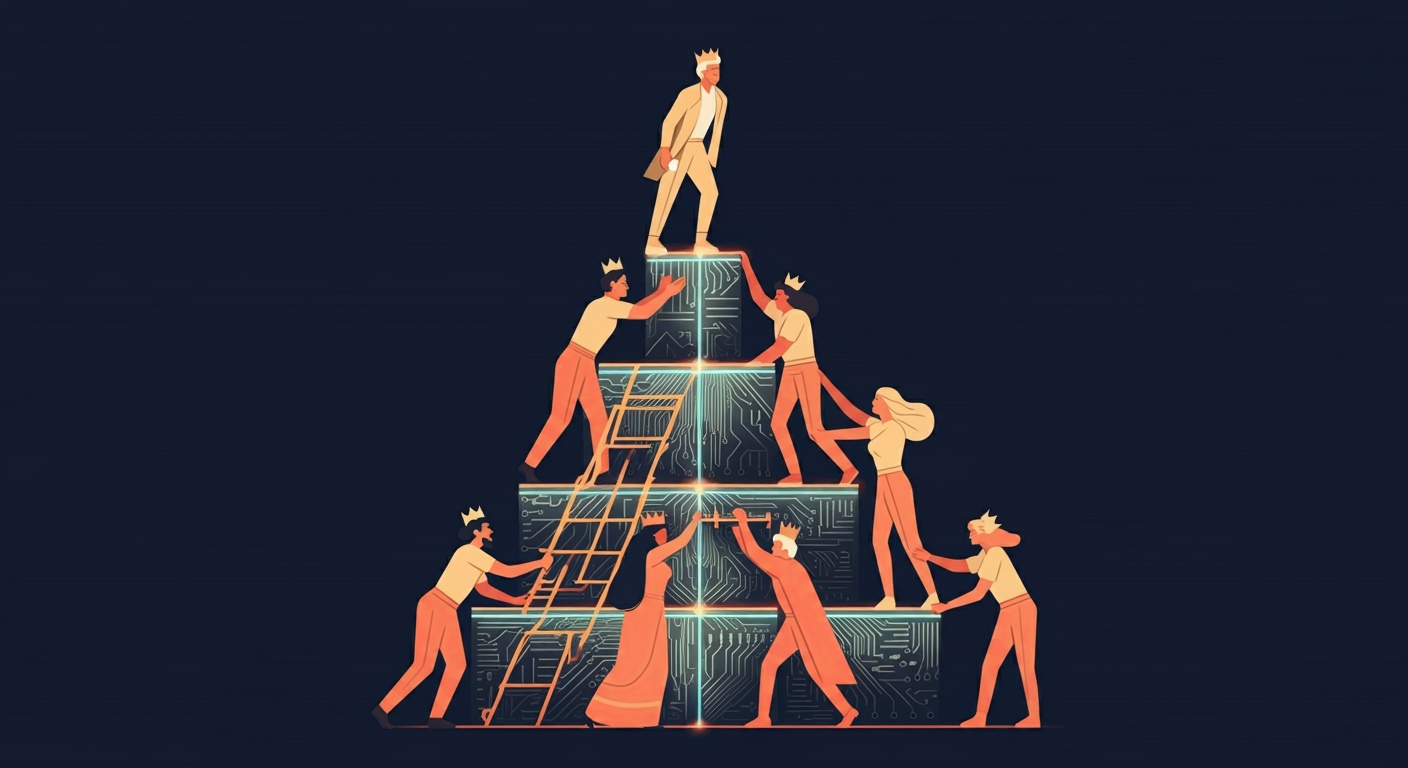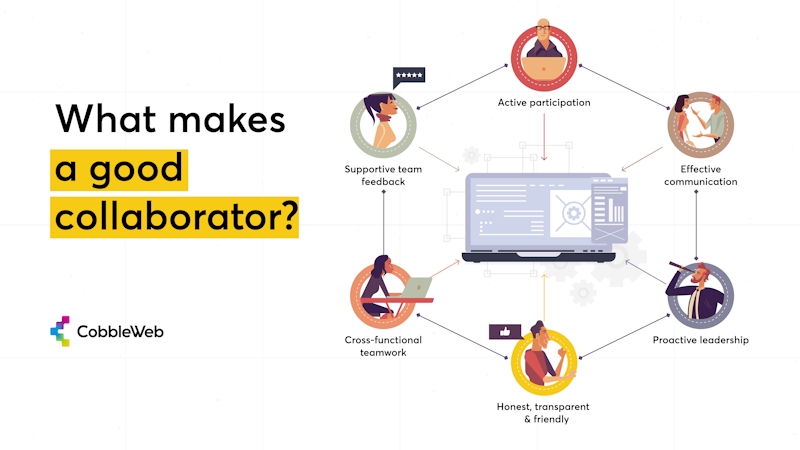Our Culture: Collaboration Kings & Queens

Collaboration is part of our DNA at CobbleWeb. It is vital to the success of our clients’ projects and the viability of our company. It ensures that all team members are aligned, informed, and able to work together efficiently to achieve common goals.
Hopefully this article will answer most of your questions about our collaboration culture: why is it so important in marketplace development, what does collaboration look and feel like at CobbleWeb, and how do you know if you are a great collaborator?
7 reasons why effective collaboration is critical in the development of custom online marketplaces
Complex Systems Require Diverse Expertise
In software development, particularly in the creation of custom online marketplaces, effective collaboration is not a luxury — it’s a necessity. These platforms are among the most complex digital ecosystems, requiring seamless integration of diverse technologies, adherence to regulations, and a user experience that meets the high expectations of modern consumers. Achieving this complexity demands input and expertise from multiple disciplines, making collaboration the linchpin of successful development.
“Great products are not built in isolation. They’re the result of diverse minds working together to solve complex problems,”
– Marty Cagan, a partner at Silicon Valley Product Group
Better Problem-Solving Through Cross-Functional Teams
Collaboration brings together different perspectives and experiences, which enhances problem-solving. A challenge in one area — for example, integrating a third-party API — might be solved more efficiently with input from DevOps, security experts, and front-end developers.
“The more perspectives you have in the room, the better chance you have of catching potential issues early and designing better solutions,”
– Brian Balfour, CEO of Reforge
Aligning Technical Development with Business Goals
Custom online marketplaces are not just technical projects; they are strategic business ventures. Collaboration between product managers, software engineers, and client marketing teams ensures that the platform aligns with business objectives, such as:
- Increasing user acquisition and retention.
- Optimising conversion rates and revenue streams.
- Expanding into new markets or user segments.
Without this alignment, developers might focus on features that don’t move the needle for the business, wasting time and resources.
Ensuring Seamless Integration Across Components
Marketplaces rely on a range of interconnected components:
- User onboarding flows.
- Search and product navigation.
- Order management systems.
- Payment gateways and third-party integrations (e.g., logistics and IoT).
Each component must work seamlessly with the others. Collaboration ensures that integration points are well-designed, tested, and maintained. Without collaboration, siloed development can lead to mismatched interfaces, buggy integrations, and a poor user experience.
When Uber built its ride-hailing platform, it had to integrate real-time GPS tracking, dynamic pricing, and a payment system. Effective collaboration between these teams ensured that users experienced a smooth ride from booking to payment.
Accelerating Development and Time-to-Market
Collaboration can significantly speed up development by facilitating knowledge sharing and reducing bottlenecks. Cross-functional teams can work in parallel on different aspects of the marketplace, reducing dependencies and accelerating the overall timeline.
CobbleWeb, like Spotify, uses a squad-based model where each squad is responsible for a specific feature or function. This decentralised approach, coupled with strong collaboration, allows us to release new features rapidly while maintaining high quality.
Encouraging Continuous Improvement and Innovation
Collaboration fosters a culture of continuous learning and improvement. Regular communication between teams enables the sharing of insights, lessons learned, and innovative ideas that can enhance the marketplace.
“Innovation is often the result of cross-pollination between different disciplines,”
– Jeff Bezos, founder of Amazon
Building Resilience and Adaptability
Online marketplaces operate in a dynamic environment with evolving technologies, regulations, and consumer behaviors. Collaborative teams are more resilient and adaptable, as they can quickly respond to changes and pivot when necessary.
When GDPR regulations were introduced in Europe, marketplaces like eBay and Booking.com had to quickly adapt their data handling practices. Collaboration between legal, engineering, and data teams ensured compliance without disrupting the user experience.
Collaboration culture at CobbleWeb
We require strong communication skills – clear, concise, and empathetic interaction, both in written and verbal forms.
We value teamwork – working harmoniously with others, leveraging collective strengths, and contributing to a positive and productive work environment.
We create a non-toxic environment – you are allowed to ask questions or challenge existing thinking (in a constructive manner).
We believe in one best way – we don’t reinvent the wheel. If there’s a proven best way, we don’t need to waste time with unnecessary debates.
We have a flat hierarchy – our minimal levels of delegation strongly support collaboration and ownership. Our experience has shown that Level 3 delegation is the sweet spot for effective collaboration.
How does collaboration work at CobbleWeb?
Team members work in squads with high levels of collaboration. They are therefore encouraged to critique each other’s ideas during grooming and discovery sessions. This requires proactive communication, active listening, and a willingness to assist. In addition, we believe that humility and respectfulness contribute towards positive, productive team dynamics .
Collaboration FAQs
- How many standard meetings do we have per day/week/month?
- We have one weekly meeting for each project during which we discuss current and upcoming sprints and tickets, as well as any overall issues with the project.
- Technical requirement meetings are scheduled ahead of each epic – usually two per month.
- This is followed by an estimation meeting for the sprint’s tickets..
- Internal demos are scheduled depending on the sprint progress or size. They include a retrospective in which we discuss what worked and what can be improved.
- How does collaboration happen outside meetings?
We usually communicate via Mattermost, Jira for ticket specific discussions, and Gitlab for discussions around code.
Communication with clients is done via Jira support tickets and email.
- What happens when someone has an urgent question?
We rely on our Mattermost channels in such instances. You can either @ someone directly if the issue concerns that individual specifically or you can direct your query to channel or here to get an answer from everyone.
- How do we help someone who is struggling?
If it is a technical issue whoever is available will try to mentor or provide reference documentation. We can also use screensharing and peer programming. If it’s a productivity issue, we try to redistribute the workload. Sometimes that entails adjusting the work environment such as simplifying processes or choosing different tools.
- How often do engineers collaborate with clients?
Senior engineers usually collaborate with clients during the last mile before going live. We often have to confirm budgets, preferences or strategies with the client. Dealing with them directly streamlines the process and avoids delays.
- What is the level of collaboration outside the immediate squad – e.g. with the product manager, designer, QA, etc?
At CobbleWeb, engineers’ inputs on design and functional specifications are valued. Especially during the discovery phase, engineers will review the design and might request changes.They are also at liberty to ask the Product Manager for validation or clarification of functional specifications.
- Which steps of the design process are engineers involved in?
The PM discusses the scope of the epic with the client to clarify the functional requirements of each feature(s). Our design team uses those requirements to create a draft design.
The engineering team then reviews the design by dropping comments on the Figma file. They consider the following aspects: suggestions to improve the UI/UX, feasibility issues (removing or revising functionality), delivery speed (should some functionality be descoped?), and clarification of missing elements.
- How are technical requirements managed?
Generally, a senior developer is nominated to lead an epic and write its technical specifications. This will include the tech stack, any tools we are going to use, and the way we are going to develop the feature. It also covers database models, API endpoints, and service or business layer changes.
Once the first version is completed, the epic leader will organise a meeting to discuss them. Revisions are made based on feedback which are usually reviewed and approved asynchronously by the rest of the team.
The epic leader then creates tickets based on the technical requirements. Once the tickets have been estimated, prioritised, and allocated development can commence.
- How are internal demos organised?
When development is completed for an epic, the owner(s) of the epic present an internal demo to the team. Any bugs or areas for improvement are added to a notes section on the internal demo document.
This is followed by a retrospective where we discuss individual feedback on what worked and what can be improved. Agreed on actions are added to the document.
Are you a collaboration king or queen?

If you tick these boxes, you probably are 👇
Great communicator?
Someone with effective communication skills can explain complex concepts in a way that is easy to understand, avoiding unnecessary jargon. They are able to deliver their messages succinctly without omitting critical information. Additionally, they show empathy by understanding others’ perspectives and responding considerately. Demonstrating active listening, they provide relevant feedback and ask insightful questions to ensure mutual understanding.
Good at giving and receiving feedback?
Constructive team members offer specific, actionable, and supportive feedback, helping their fellow team members improve and grow. They are also open to receiving feedback, viewing it as a tool for personal and professional development. Their approach to feedback fosters a culture of continuous improvement and mutual respect within the team.
Firm believer in the power of teamwork?
Collaborative people actively participate in team discussions and contribute meaningfully to group tasks. They ensure that fellow team members are kept informed and on the same page by being prompt and responsive in their communications.
When conflicts arise, they handle them constructively, aiming for solutions that are acceptable to all parties involved. Their flexibility allows them to adapt and compromise to achieve the best outcomes for the team.
Collaborators don’t believe in silos – they promote communication with team members across functional areas, such as design, development, and product. They work to integrate insights and contributions from various disciplines into a coherent final product, ensuring that all team members are aligned with the project goals and understand their role in achieving them.
Good people?
CobbleWebbers are compassionate, respectful, and willing to go the extra mile. Their professional, but cordial, behaviour contributes to a positive team dynamic. They practice active listening and proactive communication, ensuring that conversations are balanced and respectful.
Good people exhibit honesty and transparency, admit when they are wrong or do not know something, and openly communicate their expectations. This fosters trust and strengthens the team, making it easier for members to express criticism and accept vulnerability, ultimately leading to a more cohesive and effective team.
Leadership qualities?
Can you take charge, behave proactively, and apply lateral thinking?
People who exhibit leadership in teams can facilitate meetings and discussions effectively, ensuring that all voices are heard and valued. They encourage quieter team members to contribute, fostering an inclusive environment where everyone’s input is considered. Understanding the importance of delegation, they appropriately assign tasks based on team members’ strengths and workload, optimising team efficiency and morale
A final word from Steve Jobs on collaboration
“A team working really hard on something they’re passionate about polish each other. And they polish the ideas and what comes out at the end.”
Steve Jobs
Is CobbleWeb the right fit for you?

CobbleWeb helps early-stage entrepreneurs, tech startups and growing companies to conceptualise, design, build, improve, and launch successful online marketplaces.

Our custom user-focused approach to marketplace development increases our clients’ opportunities for success.

CobbleWeb has helped more than 30 startups and established companies design, build, test, and improve high-growth online marketplaces.